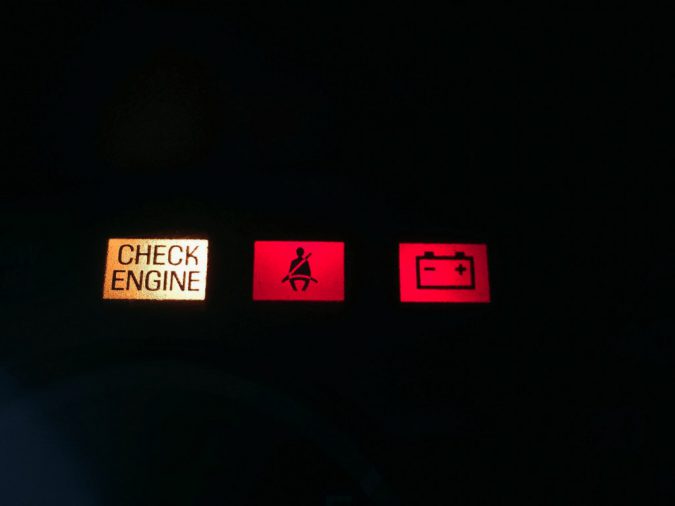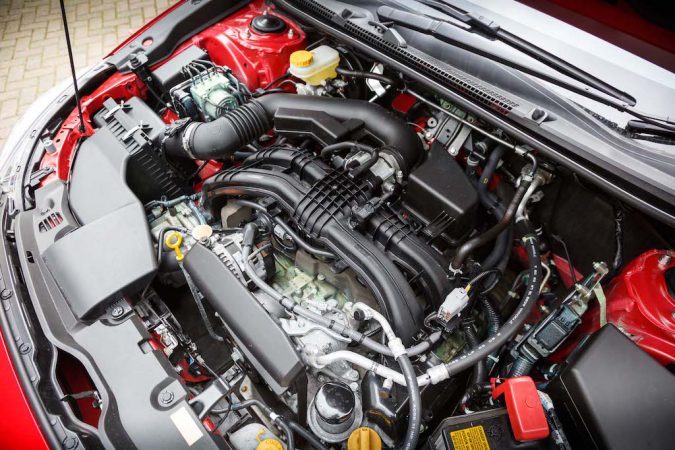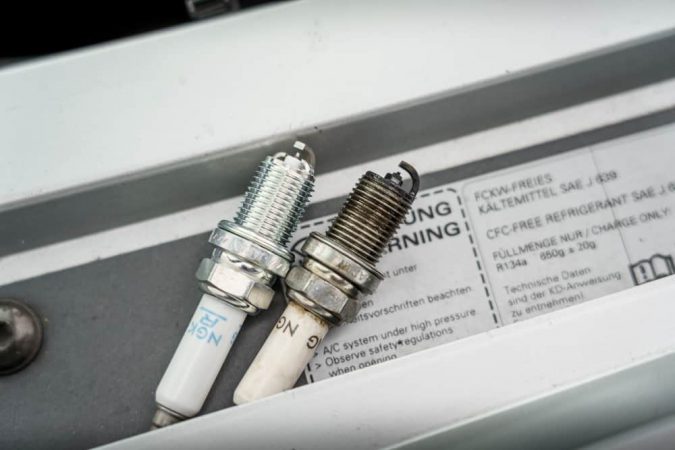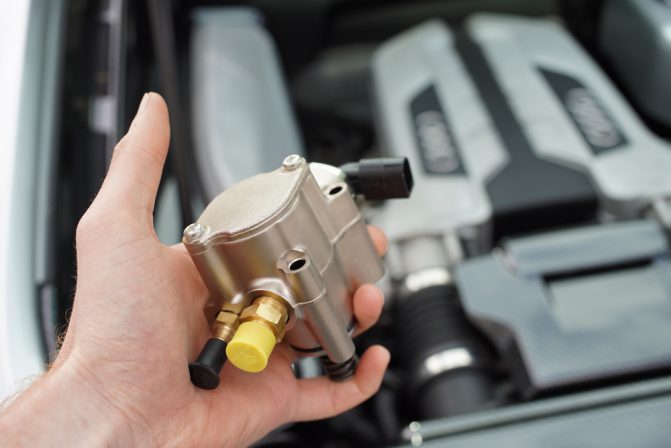Modern-day engines require a specific amount of fuel to function properly. You may know what a fuel pump relay is. This component can be found inside a vehicle’s fuel tank and it is responsible for creating pressure through the fuel lines so gasoline is pushed to the combustion engine. There are multiple reasons why a fuel pump can go bad.
“Relay” translates to “to receive and transmit.” When the ignition is turned on, the job of the fuel pump relay is to supply the necessary voltage to the fuel pump. If there is a problem with the fuel pump relay, there will be issues with the fuel pump. You cannot drive a car with a bad fuel pump relay.
A poor or malfunctioning fuel pump relay displays symptoms to let the driver know that something is wrong. Learn all about fuel pump relays, how they work, signs that the component is failing, how to diagnose, and many maintenance tips to extend its service life.
- Definition
- Location
- Function
- Bad Signs
- Reasons Behind Failure
- Diagnose
- Replacement Cost
- Duration
- How to Clean
- Starting a Car with Broken Relay
- Maintenance Tips
What Is A Fuel Pump Relay?
The fuel pump relay is an essential part of the combustion engine. Fuel is needed by the combustion engine to run, and the fuel pump relay ensures there is never a dearth of that to the engine. It is generally controlled by the Powertrain Control Module (PCM) or the ignition.
When the ignition is turned on it activates the fuel pump relay and it starts supplying electricity to the pump. In contrast, when the ignition is shut off, the power is cut off.
Location Of The Fuel Pump Relay
In most vehicles, you can find the fuel pump relay in the fuse box inside the engine bay. It is a long black box containing many relays and fuses. If you want to know more, make sure to check out this video.
If it’s not in plain sight, refer to the owner’s manual as the fuel pump relay could be located in various parts depending on the model and make of the car: on the firewall, under the hood, or near the steering column.
Function
Once the key in the ignition is turned to start the car, the combustion engine’s “start cycle” begins. Activated for long enough, the fuel pump relay supplies the required current to move the fuel pump. Although a little voltage is produced, it is consistently supplied to the fuel pump.
The fuel pump relay is turned off once the engine starts running. When the ignition is shut off, the fuel pump relay is once again engaged, only long enough to shut off the fuel pump and power down the engine.
Signs Of A Bad Fuel Pump Relay
One thing about a malfunctioning fuel pump relay is that the signs are so obvious, you will know right away. That’s right; it’s not a silent killer! The vehicle will stall, stutter, have poor acceleration as well as some other complications. That’s assuming you can get the car started in the first place.
Engine Not Starting
One of the most common signs of a bad fuel pump relay is the engine refusing to start. You crank the key many times but there is no response from your vehicle.
That being said, the no-start issue can be caused by several other malfunctions too, so it’s important to conduct a thorough investigation before concluding.
Engine Stalls
As we mentioned before, the fuel pump relay is supplying voltage to the fuel pump for the entire time the car is on. So if the stalling, that means the fuel relay’s power supply isn’t consistent.
If the engine doesn’t start and stalls, your vehicle is experiencing a malfunctioning fuel pump relay that has to be replaced.
Loss Of Power
The primary culprit behind the loss of power while driving the car is a malfunctioning fuel relay. However, this doesn’t necessarily mean that the car will stall. It could run like normal for a few minutes before it starts slowing up automatically.
Silent Fuel Pump
When you turn the ignition on, there should be some sound from the fuel pump relay. This is one of those cases where noiseless operation is a bad thing. The fuel pump is placed in the fuel tank, close to the vehicle’s rear. It produces a sound once the engine starts.
A good fuel pump relay combined with a good fuel pump produces a collection of low-volume whines or hums that you can hear from inside or outside the vehicle.
In event of a failed fuel pump relay, the car will be unnaturally silent.
Illuminated Check Engine Light (CEL)
A Check Engine Light will let you know when something is up with your car (in most cases). An illuminated CEL means the ECU has a few trouble codes stored. To read the code, you must hook the car up to an OBD2 scanner. Codes P0230 or P0231 mean the fuel pump’s primary circuit is malfunctioning. The Code P0231 stands for Fuel Pump Secondary Circuit Low.

By this, the ECU is saying that the voltage readings provided by the fuel pump readings are lower than the required specifications. This, however, doesn’t indicate a direct problem with the relay. This issue can also be caused by a shorted fuel pump, a blown fuse, a blown circuit, or frayed wiring.
A list of the most common DTC codes you will see for this problem:
- P0230
- P0231
- P0420
- P0627
- P0628
High Vehicle Mileage
While not a direct indication, the growing age of your vehicle is a message that many parts of it will start to malfunction now. If your car has a high mileage to its name, include a fuel pump relay check in the regular performance maintenance checks to ensure it’s in top-notch condition.
Burning
The worst of the symptoms, a burning fuel pump relay is caused due to high voltage or current. Fortunately, this is a very rare incident. You cannot DIY a fix for this repair thus, you have to bring the vehicle to a certified professional as soon as possible.
If you have some basic mechanic skills, you might be tempted to repair many of your car’s problems on your own. Do it if you’re confident enough. But do remember that you can void the warranty on the parts and/or end up doing more damage to the car than good.
Reasons Behind Fuel Pump Relay Failure
Fuel pumps function with the engine continuously, delivering high pressure to the injectors and fuel rails. Since the pump is always under the fuel, it works smoothly while remaining cool. Some drivers empty the tank before refilling it. This exposes the fuel pump to more heat thus reducing its general lifespan.
When the car has very little fuel and turns off the engine, the fuel is drained from the priming chamber. Similarly, when the engine is started, the pump eats it up and stays un-primed till you pour fuel into it. If this becomes a regular practice, it burns the pump motor, inducing a total failure in the fuel pump.
Electrical power surges, dust, and a handful of other factors can also make the fuel pump relay malfunction. Sudden voltage change and dust affect the performance of the pump relay, forcing the engine to react in negative ways.
Steps To Diagnose A Malfunctioning Fuel Pump Relay
Suspecting a bad fuel pump relay in your car? Here are some steps to confirm your doubts.
Step 1. Park The Car On Level And Safe Ground
Make sure to put the transmission in Park or Neutral and engage the parking brake. It’s best if your vehicle is sitting inside a garage; we will explain why later.
Step 2: Don’t Start The Car But Turn The Ignition Key On
Pay close attention to any sounds coming from your vehicle as the key is turned. This is why we suggest parking the vehicle in a covered garage as it will most likely be much quieter than an open road. Listen for a clicking sound or faint buzzing.
But it is next to impossible to hear any sounds from the fuel pump in selected vehicles. If that is the case, skip this step.
Step 3: Lift The Hood And Find The Relay
Remove the cover of the large fuse box (it holds the relay) and check the diagram. The wiring diagram will tell you where the fuel pump is.
Step 4: The Sound Tells
You should be able to hear some sounds from a healthy vehicle. But one with a faulty fuel pump relay produces no sound, even if the hood is raised. You can ask someone to help you out. If you can hear no sound at all, this is a sign that you should test the vehicle.
Step 5: Delink The Negative Cable From The Battery
Using a socket or wrench set, detach the negative cable from the car’s battery. By doing this, the power to the fuel pump as well as all related circuits are disconnected.
Step 6: Take Out The Fuel Pump Relay
You should be able to do it by hand. Alternatively, a pair of needle-nose plyers would come in handy.
Step 7: Bring In A Multi-Meter Tool
Set the tool to resistance mode. The majority of fuel pump relays come with 4 main pins: input voltage, ground, battery, and load. The load is directly linked to the fuel pump wiring. Attach the multimeter’s probes to the battery and load pins in the relay.
You have to use a 12V voltage regulator or power supply to give the relay power. Connect the ground pin in the relay to the ground of the power supply.
Replacement Cost
The average cost of replacing a fuel pump relay is between $90 to $150. In comparison to several other parts of a vehicle, this is one of the cheaper components. The part itself costs no more than $20 to $50, but combine the labor costs and it might cross the 3-digit mark.
Vehicle repair costs can be divided into 2 sections: components cost and labor cost. Getting the same work done is costlier in a dealership than at a small repair shop. Labor cost varies between shops, even from one state to another.

Bringing your vehicle to a repair shop is significantly cheaper but some people like repairing their cars at the manufacturer’s dealerships. Dealerships have in-house specialists and trained mechanics with specific knowledge in those cars.
Some people like to fix their vehicle’s problems by themselves. DIY can be a cost-efficient option if you are familiar with the parts of a vehicle. If not, you will surely make the situation worse and make the bill larger. Avoid further complicating the problems and simply take the vehicle to someone who knows what they are doing.
Buying a fuel pump relay is pretty simple. You can find one in places like Amazon, Walmart, eBay, and physical car parts stores.
How Long Does A Fuel Pump Relay Last?
A fuel pump relay is one of the more reliable components of a vehicle. It is designed to last as long as the rest of your car. But, it is prone to damages and will need repairs from time to time.
Typically, the coil and contact points of the fuel pump relay get damaged early due to oxidization, tear, rust, and usage over time. Keep in mind that a fuel pump relay is generally not checked during maintenance. Once a problem is identified, you have to get it changed by a professional immediately.
Thus, there is no fixed period to let us know how long a fuel pump relay can be expected to last. This largely depends on driving style, the choice of fuel, and where the car is being driven.
How To Clean
Why pay extra to clean the fuel pump at the repair shop when you can simply do it at home? It’s an easy task so make it a part of your routine checkups.
Debris easily accumulates in the fuel pump. In addition, overexposure to heat impedes its performance. As the fuel pump relay runs on electricity, be extremely careful when handling it.
To start, remove the relay and blow off the dust and dirt using a blower. Keep the blower over it for a minute or two. Never use water. However, a little ethanol would be the perfect cleaning agent. Only use the cleaner once the relay is clean and devoid of debris.
Apply a thin layer of ethanol to the relay and rub it carefully to take off any additional dirt. This also prevents the part from collecting dirt too quickly. Leave the fuel pump relay out to dry in someplace airy.
How To Start A Car With A Broken Fuel Pump
We strongly recommend fixing the car at the mechanics before attempting to drive it. The best solution to a faulty fuel pump is the replacement of the broken part. When you keep driving with a bad fuel pump, it damages the engine and might give rise to more complex problems.

No matter how pro these tips seem, starting a car with a malfunctioning fuel pump is strictly a temporary fix, not a solution. The faulty fuel pump burns out the motor. So, without wasting any time, find a good local mechanic or contact your dealership to set an appointment. Please refrain from taking this problem lightly.
But in dire conditions, you may have to start your car. For instance, to drive to the dealership. Below are a few tips to help you start a car with a poor fuel pump:
Use Fuel Pressure Gauge
This amazing diagnostic tool helps you keep an eye on the fuel system to make sure the engine is operating at peak performance levels. The work of a fuel pressure gauge is to monitor the fuel pressure to prevent damages to the injectors and fuel pump of the vehicle.
A fuel pressure gauge is so reliable that even mechanics use this when they are trying to fix a bad fuel pump. Despite being a reliable technique and tool, using a fuel pressure gauge still counts as a temporary solution.
To use a fuel pressure gauge, attach the tool to the engine of your car. Not only will it start the car that would otherwise be dead or stall every 5 minutes, but it will also provide an idea of if the engine is failing or not.
Exert Some External Pressure
Our next tip on this topic is to apply a little external pressure to the vehicle. The biggest issue with a faulty fuel pump is that decreases the necessary pressure – pressure needed by the car to function. In the end, the car suffers from performance issues.
Apply external pressure to the vehicle. The source of the pressure will help the car maintain the needed pressure level and the engine will be able to start and run.
Keeping The Engine’s Heat
Heat is an essential element inside the car’s engine that keeps the vehicle alive and running. The reason your car will start, regardless of whether it has a good or bad fuel pump is that when the car cools down, there is a reset. The fuel pump resets without the needed heat and pressure. An immediate malfunction is caused, disrupting the vehicle’s performance.
Thus, the optimum method to start a car with a malfunctioning fuel pump is proper regulation of heat in the engine of the car. The car will not malfunction as frequently and will have a more stable performance.
Just because you can start a car with a bad fuel pump relay doesn’t mean you should! If it’s not an emergency, we don’t encourage it. If not taken care of, a poor fuel pump can be the carrier of multiple other side problems for your vehicle. A list of side effects as a result of keeping a faulty fuel pump:
- Power loss
- Reduced fuel economy
- Surging
- Engine sputtering
- Frequent engine failures
- Overheating of the engine
Automobile experts generally suggest that you don’t use a car with a faulty fuel pump. The above-mentioned methods can be tried but there are plausible risks associated with them – and the risks are high. Get your car’s fuel pump fixed at your earliest convenience to avoid expensive and troublesome repairs. Optimal engine performance isn’t something you want to skip on.
Maintenance Tips
Prevention is better than cure. Similarly, preventing the failure of the fuel pump is much easier and cheaper than replacing the part once it has gone bad. Below are a few of the methods you can use to increase the lifespan of the fuel pump.
- Using high-quality, renowned fuel generally keeps many problems at bay. Try to buy fuel from high-volume stations only. If the price doesn’t bother you, why not?
- Purchase the best quality, free-from-debris fuel.
- Keep the gas tank somewhat filled – at least a quarter of the way full.
- Conducted routine maintenance for the filters and fuel system regularly. Replace or repair if necessary.
- Don’t empty the fuel tank. We mentioned before how this allows too much heat into the tank, decreasing its service life.
- Refrain from purchasing fuel in a gas station immediately after it has filled up a tanker truck. When a large vehicle such as this one is being refilled, the debris at the bottom is stirred up.
Fuel Pump Relay Facts:
- The fuel pump relay is an electronic component found in virtually all vehicles with an internal combustion engine.
- It functions as the primary electronic switch that controls power to the fuel pump, usually located in the engine bay’s fuse box.
- The fuel pump relay is usually controlled by the ignition or Powertrain Control Module, which provides current to the fuel pump.
- A bad or failing fuel pump relay can cause drivability problems and issues with the fuel pump.
- One of the first symptoms of a bad fuel pump relay is an engine that suddenly stalls while in operation.
- A faulty fuel pump relay may allow the vehicle to be restarted a short while later, while a completely failed relay will not.
- An engine that does not start could also indicate a faulty fuel pump relay because the fuel pump will be left without power.
- A lack of noise from the fuel pump when the key is switched on could also indicate an issue with the fuel pump relay.
- Most fuel pumps produce a low-volume hum or whine which can be heard from inside or outside the vehicle.
- If you suspect that your fuel pump relay is having an issue, have the vehicle inspected by a professional technician to determine if the component should be replaced.
Ending Notes
Although the fuel pump relay will impress you with its durability, it isn’t immune to damages. Many signs indicate a faulty fuel pump relay – don’t ignore those. The sooner you diagnose the problems, the sooner you can repair your car, and the sooner you can get back on the roads with decently performing vehicles.
Having said that, many of these symptoms could be related to another problem. Whatever the cause may be, the moment you notice any of the symptoms we talked about above, your car will need an inspection.

